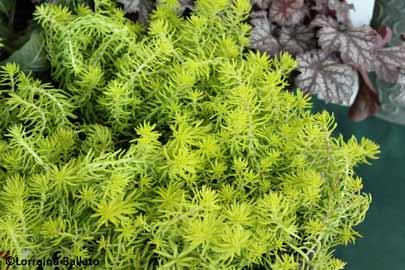Remember how some years it is very dry? If it happens this year, now may be the time to seriously consider xeriscaping, a landscaping concept which focuses on conserving water and having a less water-hungry garden. As you make this transition, you might even save some money in the long run by using less water, and, therefore, less electricity running the pump – not to mention lowering your bill and putting less wear and tear on your entire water system and you, the gardener. Where to start?
The first thing you can do is add organic matter to your soil which always improves drainage and the ability of the ground to retain moisture as well as feed whatever is growing where you put it. Every time you plant you have the opportunity to do this. Organic matter can be compost, aged manure and other decomposed vegetative matter like pine needles.
The second thing you might consider is where you have grass in other parts of your property. Can the swing set and all other structures in your children’s play spaces be put on beds of sand? How about a patio or deck to handle cooking and eating areas? Maybe set up your favorite outdoor shady sitting and reading nook over a blanket of great smelling cedar mulch, which also repels insects. Surprise Dad for Father's Day with a comfortable hammock to string between two trees and put it over a carpet of cedar mulch. Some gardeners decide to clear the grass for a garden ornament or two positioned on a swath of gravel.
 3 ladies garden sculpture
3 ladies garden sculpture
©Lorraine Ballato
A third idea is to replace grass with other plant material like less thirsty ground covers. Try this sedum (Angelina), or a shade tolerant and deer resistant perennial like bigroot geranium (geranium macrorrhizum), and other drought tolerant plants.
 Sedum rupestre 'Angelina'
Sedum rupestre 'Angelina'
©Lorraine Ballato
Easy-to-find annuals like snapdragons and cosmos are low maintenance and very drought tolerant. Evergreen Alberta spruce add year-round color combined with deer resistance and low water needs. They make a superb backdrop for yuccas, like this Yucca Filamentosa Color Guard which thrive in sunny and dry sites.
 Yucca filamentosa 'Color Guard'
Yucca filamentosa 'Color Guard'
©Lorraine Ballato
A xeriscape plan wouldn't be complete without mulch, one of the best ways to conserve moisture. Organic mulches like cedar, pine or shredded leaves will enrich the soil so that whatever you plant will be healthier and stronger as a result. Mulch also keeps weeds down so your gardening chores will be easier and greatly reduced.
Alas, we’re all suckers for some plants which are water hogs. When you have them in your landscape, group them with other plants which require a lot of water. That way, your watering chores will be more efficient.
Whether you're fully committed to transitioning to xeriscaping or prefer to have only a section or two within your overall landscape plan, taking small steps with a project or two is a great place to start.
by Lorraine Ballato, Garden Writer and Author